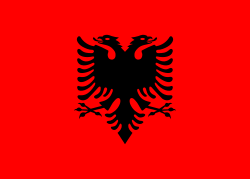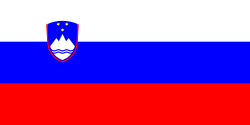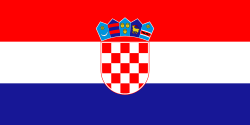Italiensk (sprog)
| Italiensk (italiano) | ||
|---|---|---|
| Talt i: | • Italien • Schweiz • San Marino • Albanien • Vatikanstaten • Slovenien • Kroatien • Malta | |
| Region: | Sydeuropa | |
| Talere i alt: | Knap 64 millioner som modersmål[1] | |
| Rang: | 21 | |
| Sprogstamme: | Indoeuropæisk Italisk Romansk Italo-vestlig Italo-dalmatinsk Italiensk | |
| Officiel status | ||
| Officielt sprog i: | Officielt minoritets sprog i dele af:[2] | |
| Reguleret af: | ingen officiel regulering | |
| Sprogkoder | ||
| ISO 639-1: | it | |
| ISO 639-2: | ita | |
| ISO 639-3: | ita | |
 | ||
 For alternative betydninger, se Italiensk. (Se også artikler, som begynder med Italiensk)
For alternative betydninger, se Italiensk. (Se også artikler, som begynder med Italiensk)

Italiensk tilhører de romanske sprog, som alle er udviklet fra latin. Se bl.a. også spansk, portugisisk og fransk.[3][4]
Italiensk er officielt sprog i Italien og Schweiz (især kantonerne Ticino og Grigioni), foruden i Vatikanstaten og mikrostaten San Marino. Desuden er der store emigrantgrupper i for eksempel USA og Canada, der har italiensk som modersmål eller andetsprog. Italiensk tales af cirka 64 millioner mennesker i verden.[1]
Sproghistorie

Talesproget i det gamle Rom og i provinserne må tidlig have begyndt at skille sig fra den latinske standard. Efterhånden som Romerriget gik i opløsning og produktionen af skriftligt materiale gik kraftig ned, havde latin ikke nogen indflydelse på talesproget længere. Dermed udviklede talesproget sig ukontrolleret, og ændrede sig kraftigt. Blandt andet blev det komplicerede kasussystem i latin brudt fuldstændigt ned, og intetkøn forsvandt fra sproget. Fra 1000-tallet begyndte der at blive skrevet poesi og sange på mange af halvøens dialekter. Stor litteratur opstod i Firenze og Toscana på 1200-1300-tallet, skrevet af forfattere som Dante, Petrarca og Boccaccio. Dermed fik toskansk en forrang frem for andre dialekter, og blev med tiden accepteret i størstedelen af det italiensktalende område som korrekt sprog. Det er bemærkelsesværdigt at denne proces pågik samtidig med at Italien var opdelt i mange små og større stater.
Kilder
- ^ a b Ethnologue: Italian, hentet 17. februar 2016 (engelsk)
- ^ Den europæiske pagt om regionale sprog eller mindretalssprog
- ^ Simone 2010
- ^ Berloco 2018
Litteratur
- Berloco, Fabrizio (2018). The Big Book of Italian Verbs: 900 Fully Conjugated Verbs in All Tenses. With IPA Transcription, 2nd Edition. Lengu. ISBN 9788894034813.
- Palermo, Massimo (2015). Linguistica italiana. Il Mulino. ISBN 9788815258847.
- Simone, Raffaele (2010). Enciclopedia dell'italiano. Treccani.
Eksterne henvisninger
 Der findes også en Wikipedia på italiensk.
Der findes også en Wikipedia på italiensk.
| Spire Denne artikel om sprog er en spire som bør udbygges. Du er velkommen til at hjælpe Wikipedia ved at udvide den. |
Medier brugt på denne side
The Flag of Europe is the flag and emblem of the European Union (EU) and Council of Europe (CoE). It consists of a circle of 12 golden (yellow) stars on a blue background. It was created in 1955 by the CoE and adopted by the EU, then the European Communities, in the 1980s.
The CoE and EU are distinct in membership and nature. The CoE is a 47-member international organisation dealing with human rights and rule of law, while the EU is a quasi-federal union of 27 states focused on economic integration and political cooperation. Today, the flag is mostly associated with the latter.
It was the intention of the CoE that the flag should come to represent Europe as a whole, and since its adoption the membership of the CoE covers nearly the entire continent. This is why the EU adopted the same flag. The flag has been used to represent Europe in sporting events and as a pro-democracy banner outside the Union.Flag of Albania
The flag of Slovenia.
- "The construction sheet for the coat of arms and flag of the Republic of Slovenia
- is issued in the Official Gazette Uradni list Republike Slovenije #67, 27 October 1994
- as the addendum to the Law on the coat of arms and flag."
Det er let at give dette billede en kant
Forfatter/Opretter: unknown, Licens: CC BY-SA 3.0
Legend:
Forfatter/Opretter: Paolo Villa, Licens: CC BY-SA 4.0
Håndskriver kursiv, undervist på italiensk skole (XX. XXI. århundrede)
The Flag of Vatican City State, as per the 2023 w:en:Fundamental Law of Vatican City State, reproducing Annex A which contains the official depiction of this version. See 2023 Fundamental Law of Vatican City State, art. 23, n. 1.
This 2023 flag is very similar to the flag used in the 1929 Fundamental Law of Vatican City State, see here, p. 35. Thus, it is in the public domain.
Forfatter/Opretter: Petermgrund, Licens: CC BY-SA 4.0
|
Official language status
Former official language status
Presence of Italian-speaking communities
|













